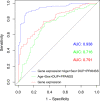Gene expression and response prediction to amisulpride in the OPTiMiSE first episode psychoses
- PMID: 32450569
- PMCID: PMC7421408
- DOI: 10.1038/s41386-020-0703-2
Gene expression and response prediction to amisulpride in the OPTiMiSE first episode psychoses
Abstract
A fundamental shortcoming in the current treatment of schizophrenia is the lack of valid criteria to predict who will respond to antipsychotic treatment. The identification of blood-based biological markers of the therapeutic response would enable clinicians to identify the subgroup of patients in whom conventional antipsychotic treatment is ineffective and offer alternative treatments. As part of the Optimisation of Treatment and Management of Schizophrenia in Europe (OPTiMiSE) programme, we conducted an RNA-Seq analysis on 188 subjects with first episode psychosis, all of whom were subsequently treated with amisulpride for 4 weeks. We compared gene expression on total RNA from patients' blood before and after treatment and identified 32 genes for which the expression changed after treatment in good responders only. These findings were replicated in an independent sample of 24 patients with first episode psychosis. Six genes showed a significant difference in expression level between good and poor responders before starting treatment, allowing to predict treatment outcome with a predictive value of 93.8% when combined with clinical features. Collectively, these findings identified new mechanisms to explain symptom improvement after amisulpride medication and highlight the potential of combining gene expression profiling with clinical data to predict treatment response in first episode psychoses.
Figures


References
Publication types
MeSH terms
Substances
Grants and funding
- FDM20151234954/Fondation pour la Recherche Médicale (Foundation for Medical Research in France)/International
- ANR-11-IDEX-0004-02/Agence Nationale de la Recherche (French National Research Agency)/International
- HEALTH-F2-2010-242114/EC | EC Seventh Framework Programm | FP7 Health (FP7-HEALTH - Specific Programme "Cooperation": Health)/International
LinkOut - more resources
Full Text Sources
Medical
Research Materials

